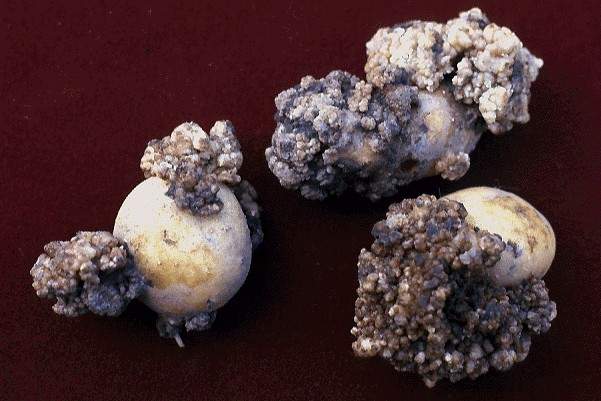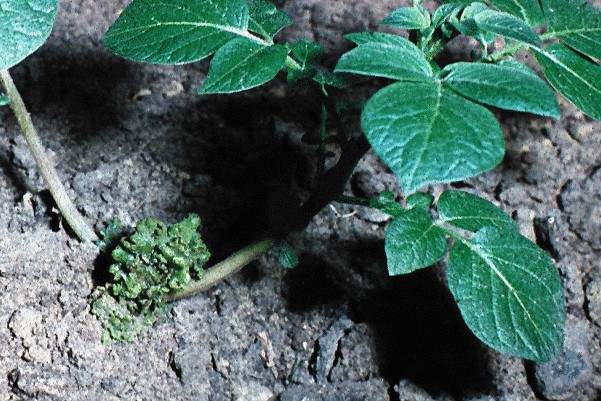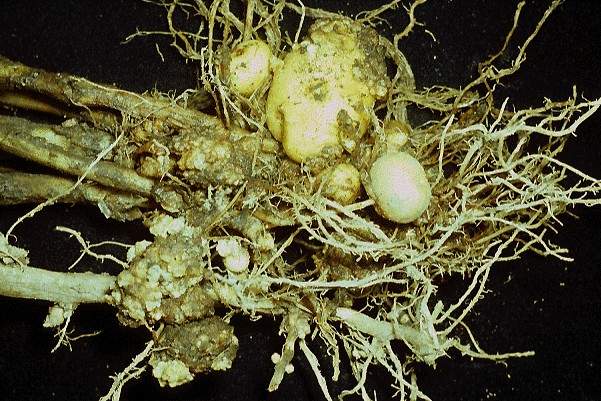
Potato wart
| Primefact number | Edition | Published | Author |
|---|---|---|---|
| 1203 | Second | Apr 2017 | Plant Biosecurity and Product Integrity |



Potato wart is a soil-borne fungal disease of potatoes. Potato wart mainly appears on underground stolons and tubers. It does not occur on the true roots of the potato plant.
The presence of the disease may not be noticed until the potato tubers are harvested.
Potato wart (Synchytrium endobioticum) is an exotic plant pest not present in Australia. This disease is a serious threat to Australia’s potato industry.
Notifiable status
Potato wart (Synchytrium endobioticum) is a notifiable plant disease in NSW.
All notifiable plant pests and diseases must be reported within 1 working day. You can report notifiable plant pests and diseases by one of the following methods:
- Call the Exotic Plant Pest Hotline 1800 084 881
- Email biosecurity@dpi.nsw.gov.au with a clear photo and your contact details
- Complete an online form
A full list of notifiable plant pests and diseases can be found in Schedule 2 of the NSW Biosecurity Act 2015.
Symptoms
On infected tubers the eyes develop into warty, cauliflower-like swellings (Figure 1). Warts are initially the same colour as the tuber and then turn black as the fungus matures. Warts that become exposed at or just above the soil line become green (Figure 2).
Wart size varies from small growths to large multi-branched swellings that may engulf the whole tuber. Tubers may bear more than one warty outgrowth (Figure 3). Tubers may become disfigured or unrecognisable when they are infected early in their development.
Infected plants may develop general symptoms of reduced vigour.
Symptoms associated with potato wart may appear similar to some of the symptoms caused by powdery scab, potato smut and ‘pseudo-wart’. Proper identification and laboratory analysis is required to confirm the presence of the potato wart pathogen.
Biology
Potato wart mainly appears on underground stolons and tubers. Under wet conditions, warts may occur on stems.
Potato wart symptoms can continue to develop during storage. Dried out warts barely noticeable at harvest may become increasingly obvious during prolonged storage.
The potato wart fungus does not usually kill the potato plant. If tuber sprouts are attacked by the fungus shoots may fail to emerge from the soil.
Survival
Resting spores of potato wart are capable of surviving in soil for over 30 years and at depths of over 50 cm.
Spread
Potato wart fungus has very limited capacity for natural spread.
Long distance spread occurs through the movement of infected soil and by infected seed tubers.
Hosts
The only cultivated host of potato wart is potatoes.
In Mexico wild potato species (Solanum) can be infected.
Under laboratory conditions a number of solanaceous plants including tomato have been artificially inoculated.
Distribution
Potato wart originates in the Andean zone of South America. It is thought to have been introduced on breeding material to Europe after the Irish potato famine of 1840-50.
Potato wart has been reported in Asia, Africa, Europe, North America, South America and New Zealand.
In New Zealand potato wart is restricted to home gardens in the Southland region.
Actions to minimise risks
Put in place biosecurity best practice actions to prevent entry, establishment and spread of pests and disease:
- practice “Come clean, Go clean”
- ensure all staff and visitors are instructed in and adhere to your business management hygiene requirements
- source propagation material of a known high health status from reputable suppliers
- keep records

